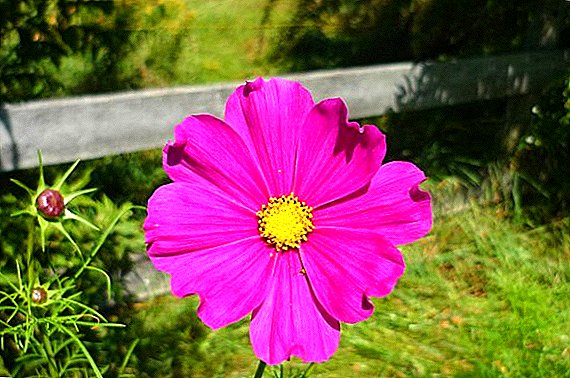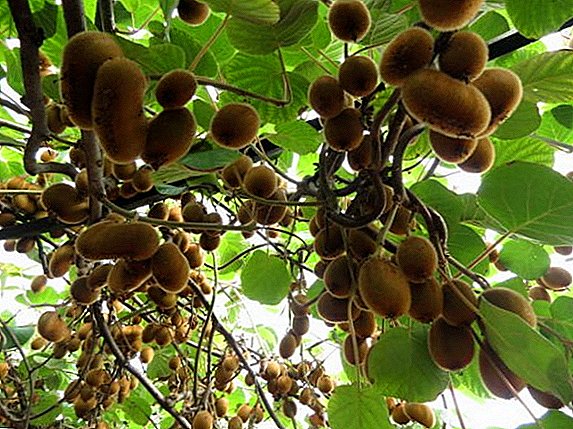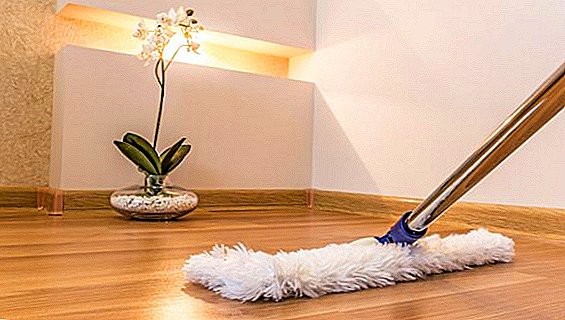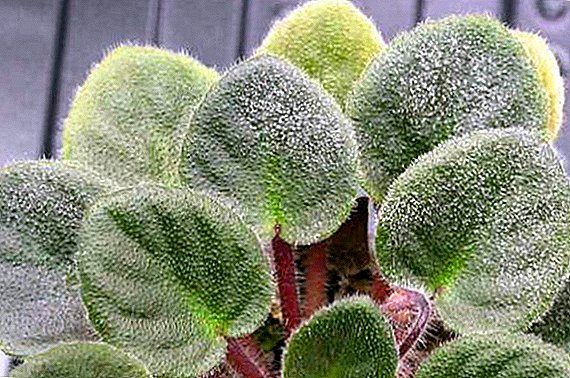 Construction technologies are developing along with the requirements that people place on residential or work premises. What the house is built of or with the help of what materials its interior is made, how safe and durable it is - all this is very important for a modern person.
Construction technologies are developing along with the requirements that people place on residential or work premises. What the house is built of or with the help of what materials its interior is made, how safe and durable it is - all this is very important for a modern person.
About gas blocks
Modern building materials must comply with many parameters. Today, the buyer imposes a number of mandatory requirements on products:
- environmental friendliness - sometimes the pursuit of cheapness turns into not immediately manifest diseases, because the category of more affordable building materials does not have an environmental passport and usually contains formaldehyde, phenol and other carcinogens;
- ease of use or installation;
- high wear resistance index;
- frost resistance;
- small weight;
- incombustibility;
- high index of heat-insulating parameters;
- soundproofing;
- affordable price.

Did you know? To have a quality rest, a person needs to sleep in a wooden house. - 6 hours, in a brick house - 8 hours, in a high-rise building of concrete slabs - 12 hours. The gas-concrete house in this list takes the second place after the wooden one. Scientists have found that a person needs only 7 hours to rest in it.
Practically all these requirements are met by aerated concrete - a modern building material, which belongs to lightweight foam concrete and is widely used in individual construction.
It is a block of different size of cellular concrete, in which gas bubbles occupy about 80% of the volume.
By its production only ecologically harmless components are used. The main component of the mixture for future blocks is quartz sand (60%), in equal parts lime and cement (20%), aluminum powder (0.5-1%) and water are used.  According to the method of its production, autoclave and non-autoclaved aerated concrete are distinguished.
According to the method of its production, autoclave and non-autoclaved aerated concrete are distinguished.
It will be useful for you to read how to erect a gable, chetyrekhskatnuyu and mansard roof, as well as how to roof the roof with ondulin or metal tile.
The autoclaved concrete production process has this scheme:
- quartz sand is placed in industrial mills of ball grinding, inside the drums there are balls, which grind the sand to the state of dust;
- crushed sand, cement and lime are mixed in a special container;
- water and aluminum paste are added to the dry mix. As a result of the reaction of lime and aluminum suspension, hydrogen is obtained. It forms in the mixture (and then in the finished product) a huge number of voids - from 1 to 2 mm in diameter;
- the mixture is poured into molds, leaving a fourth part unfilled. At this stage, the mixture resembles a yeast dough - after 2-3 hours it not only rises to the edge of the mold, but also has time to harden. Humidity in the room where the aerated concrete is produced should be increased;
- hardened material is cut into blocks of the same size, the outer side of which is polished;
- after that, the blocks are placed in an autoclave, in which steaming takes place for 12 hours at a temperature of 191 ° C and at a pressure of 12 atmospheres. Autoclaving allows to obtain such changes in the molecular structure of aerated concrete, which form an artificial mineral - tobermorite, which has unique operational properties, including increased strength and reduced shrinkage. Immediately after heat treatment, the material has a moisture content of about 30%, which decreases to 5–10% during the year;
- Ready blocks are packed and shipped to consumers.
Production of non-autoclaved aerated concrete differs only in that the final product passes the stage of autoclaving. It is a frozen porous cement-sand mortar, significantly inferior in quality to its fellow.
Video: autoclaved aerated concrete production technology
Types of aerated concrete blocks
Aerated concrete blocks differ in their purpose and form.
Did you know? Gas sculptors are actively used by sculptors, because its lightness and reasonable price allow you to create masterpieces with less physical and financial costs. Thanks to this artificial stone, a whole direction in sculpture - Ytong Art.
By appointment, they are:
- heat insulating - The main emphasis in their production is on keeping the heat in the room. Usually their density ranges from D 350, strength 0.7-1 MPa, thermal conductivity 0.08-0.09 W / (mS). Their main disadvantage is that many pores, although they provide excellent heat and sound insulation, but negatively affect the strength index;

- constructive heat-insulating - this "golden mean" not only retains heat well in the house and protects it from unnecessary noise, but is also more durable compared to thermal insulation blocks. Such products are marked with D 400, thermal conductivity coefficient of 0.1 W / (mS) and strength of 1-1.5 MPa. It is ideal not only for veneering external walls, but also for the construction of internal partitions and load-bearing walls;

- constructional - indicators of this type are the following characteristics: D 500 grade, thermal conductivity 0.12 W / (mS), strength from 2 MPa. If the choice stops on this view, as a result, the planned structure will be strong, quiet, warm in winter and cool in summer.
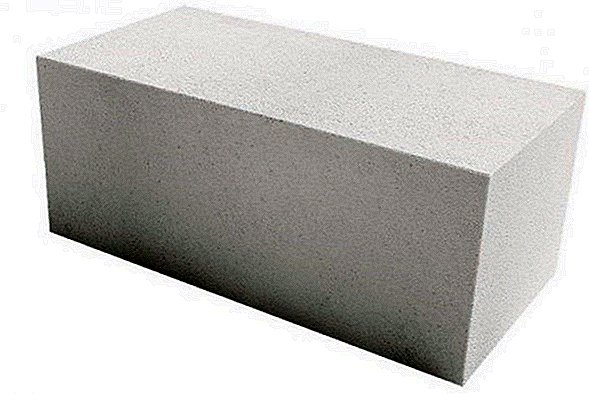
In form:
- system groove comb and hand grip - very comfortable for the work of builders. This is a quality product that significantly increases the speed of construction and minimizes the amount of material breakage. After all, it is easier to move blocks that provide grip for the hands than just polished parallelepipeds. In addition, this type saves adhesive solution significantly, because thanks to the groove-ridge system, vertical seams do not require additional fixation at all. But usually this type has less durability than ordinary polished blocks;
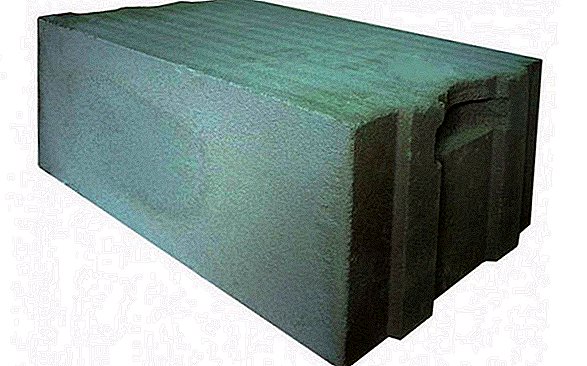
- with flat edges and hand grip - suitable for any type of masonry. It is distinguished by good compressive strength and ease of installation;
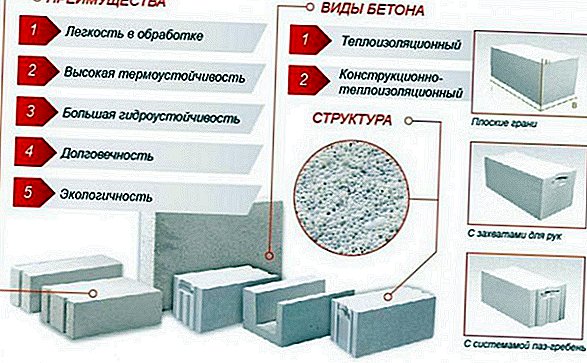
- horseshoe-shaped blocks - ideally suited for creating armored belts, ceilings above windows and doors, formwork when creating lintels and beams.
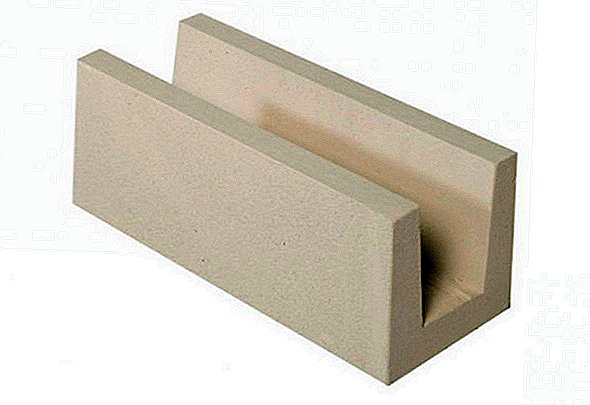
Did you know? In terms of the use of this material, France and Germany are leading (80% of construction). In second place is Spain (55%). Conservative Britain also pays tribute to this construction miracle - it ranks third in Europe for its use - 40% of construction objects are erected from aerated concrete blocks.
Advantages of aerated concrete blocks
The advantages of this product are many:
- environmental friendliness - by its production only natural components are used;
- low price - this artificial stone is much cheaper than other building materials;
- high strength;
- light weight - allows you to not attract additional equipment for construction and does not exert excessive and undesirable stress on the walls and the foundation of the building;
- provides good thermal insulation - this contributes to the cellular structure of foamed concrete;
- ease of installation - thanks to the large size of the blocks, grips, grooves and ridges allows the material to be easily transported and give it the right size;
- heat insulation - a layer of aerated concrete blocks, placed on top of the facade of the house, will ensure the preservation of heat in the house for many years;
- soundproofing;
- vapor permeability - the porous structure allows a couple to freely leave the room;
- guaranteed quality - in factories, control and availability of a quality certificate for products is obligatory;
- fire resistance - in its structure there are no combustible and combustion-supporting components.

Repair in an apartment or house requires serious preliminary preparation. That is why it will be useful for you to learn: how to remove paint from the walls, and whitewash from the ceiling, how to glue wallpaper, how to hold water in a private house, how to put a wall outlet and switch, how to make a plasterboard partition with a doorway or how to sheathe walls with plasterboard.
Cons of aerated concrete blocks
Although the list of advantages of aerated concrete is quite impressive, the material has its drawbacks. The latter include:
- low density (especially in compression);
- ability to absorb and retain moisture;
- the need to use special hardware;
- the appearance in the masonry with time microcracks and cracks.
How to choose gazobloki
When buying a building material, you can consult with the seller of the store, or ask advice from friends who understand the industry.
Video: what are the types of blocks and how to choose the right one
Important! When choosing gazoblokov need to correlate the purpose of use and technical characteristics of the purchased goods.
If you decide to choose the aerocrete yourself, then you need to know the basic criteria for quality products. Each product advantage or disadvantage has a numeric expression:
- thermal conductivity - the lower its coefficient, the warmer the room. The coefficient ranges from 0.075 W / (m • K) for marking the density of D350 and 0.25 W / (m • K) for marking the density of D700;
- density - the higher the mark, the stronger the product and vice versa - with lower marking, the strength indicators fall (but then the unit gains in weight and, if possible, perform various construction operations with it). Typically, aerated concrete has the following density values: D300; D350; D400; D500; D600; D700; D800; D900; D1000; D1100; D1200 kg / m3;
- strength - this characteristic is denoted by the letter M followed by a number measured in kgf / cm2. It indicates the average value of strength. The extent to which the quality of a material can fluctuate is indicated by the marking B, followed by a number in MPa denoting guaranteed strength. The lowest class of strength is designated as B0.35 (M5), and the most durable materials have a density indicator of 350-400 kg / m3;
- fire resistance - aerated concrete belongs to non-combustible products. Structures made of it can withstand flames for several hours;
- vapor permeability - this indicator determines the possibility of removing steam and moisture from the room. It is calculated in mg / (m.h.Pa). Vapor permeability directly depends on density: the lower the density, the higher the vapor permeability. With a density of D 600, vapor permeability will be 0.023-0.021 g / m * h, D 700 - 0.020-0.018 g / m * h, D 800 - 0.018-0.016 g / m * h;
- soundproofing - this indicator is calculated in decibels (dB). The higher it is, the better the sound insulation characteristics. The thickness of the walls and the density of the material of which the house is built, also affect the noise insulation coefficients. The higher they are, the less sound will penetrate the dwelling;
- the size - allowable from the declared deviation should be 0.5-0.8 mm. If this figure is greater, the product is a marriage.

Rules for storing gas blocks
Storage of aerated concrete blocks is simple, but requires the implementation of certain rules. When storing in the open, first of all:
- prepare in advance a flat, filled with rubble, a platform;
- take into account the terrain features - if it rains frequently, then the storage area for the blocks should be under a slight bias for the outflow of rainwater.
Important! You can not store aerated concrete blocks, dumped on a heap. This can permanently damage most products.
It should be noted that the blocks are not afraid of low temperatures. Therefore, even the coldest winters are not afraid of them.
If the original packaging has been opened, and some of the products have already been used, then the rest of the material in the printed packaging should be covered.
To do this, suitable film, tarpaulin, roofing material, pieces of old linoleum. In this form, aerocrete safely maintained until the heat and the beginning of a new phase of construction.  It must be remembered that the material reluctantly gives up water. Therefore, it is necessary to ensure that precipitation (rain, snow, melt water) do not initially fall into the materials. For this, the packing pallet must be at a height of 10-15 cm from the ground. It is necessary to check the reliability and integrity of the shelter (film, tarpaulin, etc.).
It must be remembered that the material reluctantly gives up water. Therefore, it is necessary to ensure that precipitation (rain, snow, melt water) do not initially fall into the materials. For this, the packing pallet must be at a height of 10-15 cm from the ground. It is necessary to check the reliability and integrity of the shelter (film, tarpaulin, etc.).
The presence of a canopy facilitates the already simple storage of gas blocks. Here it is worthwhile to fear only melt water, therefore it is necessary to provide for the possibility of finding material at a sufficient height from the ground.
Read also about the characteristics and application of oriented chipboard OSP-3.
Aerated concrete - a modern building material. In addition to its environmental friendliness, accessibility and other advantages, it is perfectly combined with other materials, is used in construction works of any complexity (even in sculpture).
Its universality causes an increasing demand and allows calling it one of the most popular and popular building materials on the modern market.
Feedback from network users












